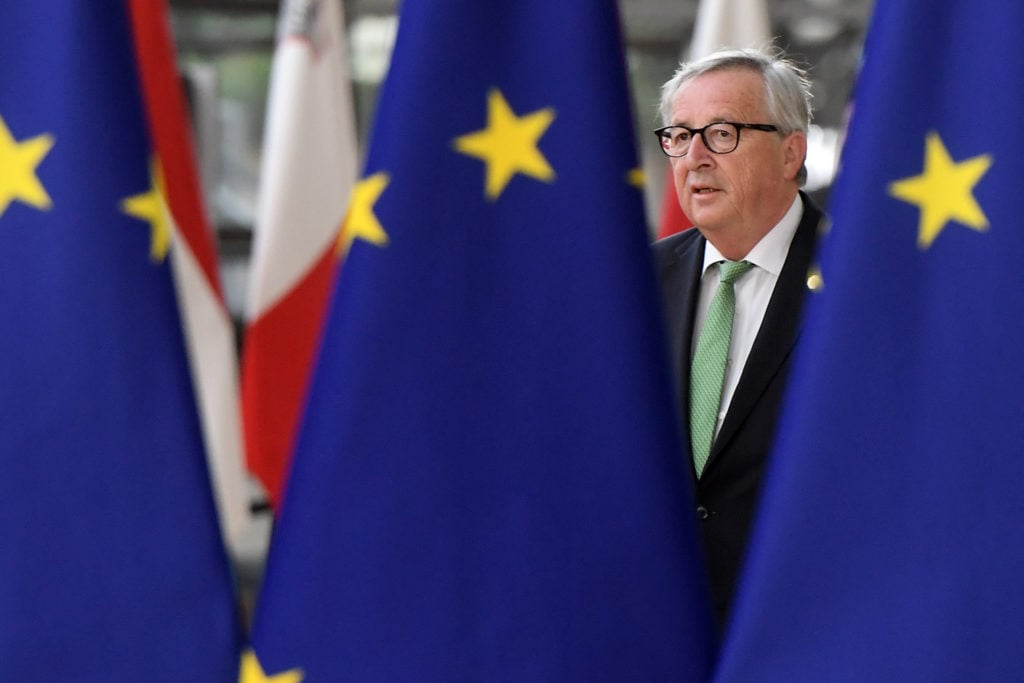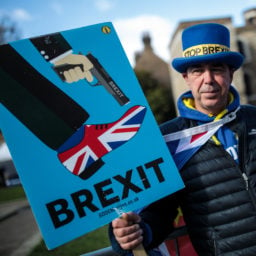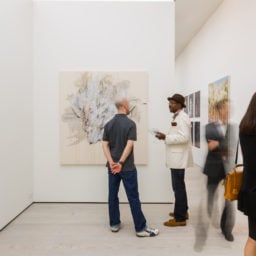The foundation is shaken but the bloc is still standing after the European Parliament elections this weekend.
Voters in 28 member nations went to the polls in a vote that many feared—or hoped—would seal the fate of the European Union. And while some right-wing and Eurosceptic parties, including Germany’s Alternative für Deutschland (AfD) and the newly minted Brexit Party in the UK, picked up seats, left-leaning Green and liberal parties across the bloc also made substantial gains, meaning that new coalitions will have to emerge for each to activate its agenda.
But for artists like the pro-Europe photographer Wolfgang Tillmans, who campaigned intensely in the weeks leading up to the elections to help increase voter turnout, the story is elsewhere.
“The real sensation got underreported: the decades-long trend of falling voter turnout in European elections has been turned around,” he wrote on Instagram the day after the election. “The good news is: Europeans care about their Union.”
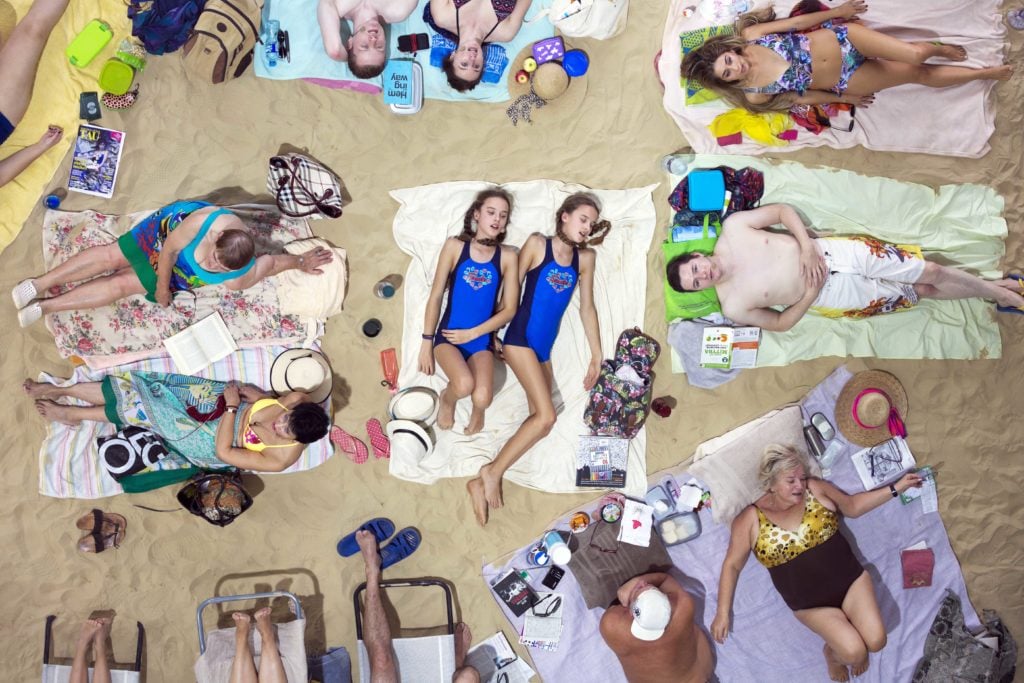
Sun & Sea, Lithuania’s contribution to the 2019 Venice Biennale. Photo: Neon Realism.
The Climate, From Representation to Reality
In many EU nations, environmental parties saw huge leaps of voter support. On Sunday evening, in reaction to the results, the founder of the far-right Danish People’s Party (DPP) justified the loss of three of her party’s seats in the European Parliament by blaming what she called the “climate fools.”
“With humour and creativity, Danes have embraced the term, readily identifying with their new climate-fool identity,” Olafur Eliasson tells artnet News. “Interestingly, the insult contains some unintended truth: To respond adequately to the current climate emergency, we must act foolishly in the eyes of those who pursue business as usual.” Last December, the Icelandic-Danish artist installed the latest iterations of Ice Watch, 24 massive blocks ice, harvested from Greenland, to let them melt in a circle outside the Tate Modern and Bloomberg’s new headquarters in London.
Climate concerns are a powerful topic for artists at the Venice Biennale, which opened earlier this month. Trio Rugilė Barzdžiukaitė, Vaiva Grainytė, and Lina Lapelytė, won the Golden Lion for their operatic performance Sun & Sea (Marina) for the Lithuanian Pavilion. The Green Party made gains in the Baltic country, taking 11.9 percent of the vote.
In Germany, the Green Party shot to second place, getting 20 percent of the vote. An even higher 33 percent of German voters under 30 gave the Green Party their ballot. These new members across the bloc, with 69 seats total, will be a powerful force of so-called “climate fools.”
Eliasson says: “As an artist I know the feeling of foolishness well.” He is proudly embracing the term. “In art, foolishness is the condition that allows us to feel destabilised, look ourselves in the eye, embrace uncertainty, otherness, and ideas that transcend our individual lives.”
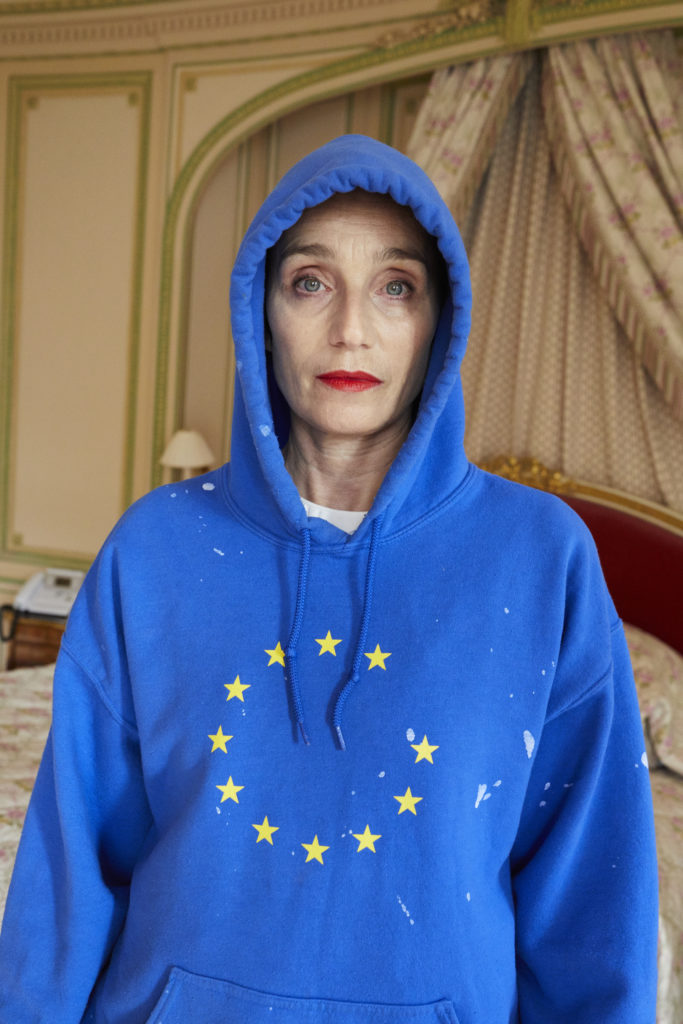
Juergen Teller’s Kristin Scott Thomas No.1 (2017). Courtesy Juergen Teller and Christine König Galerie, Vienna.
A Fractured Picture of the Union
According to Antonio Tajani, the Italian politician who is the President of the European Parliament, voter turnout was at nearly 51 percent—the highest in 20 years—which has aroused excitement among artist groups.
“We have to continue to campaign for our democratic and constitutional rights for the freedom of the arts and the freedom of speech. We are very happy about how many people showed up all across the European Union and voted,” says the Berlin-based artist Raul Walch, speaking on behalf of the group Die Vielen (The Many). The organization of cultural workers and others have been campaigning against the rise of far-right politicians. In late May, the group demonstrated in Berlin, drawing a reported 5,000 protesters. Their declaration for artistic freedom in the face of the right-wing has been signed on by many cultural institutions and museums in Germany.
Still, many people this weekend voted for parties that groups like Die Vielen stand against. In France, the National Rally party, which was formerly called the National Front and is led by Marine Le Pen, picked up 22 seats, more than any other group. In Italy, Lega Nord led the way, and in Hungary, far-right president Viktor Orbán’s party won big, securing more the 50 percent of the country’s vote.
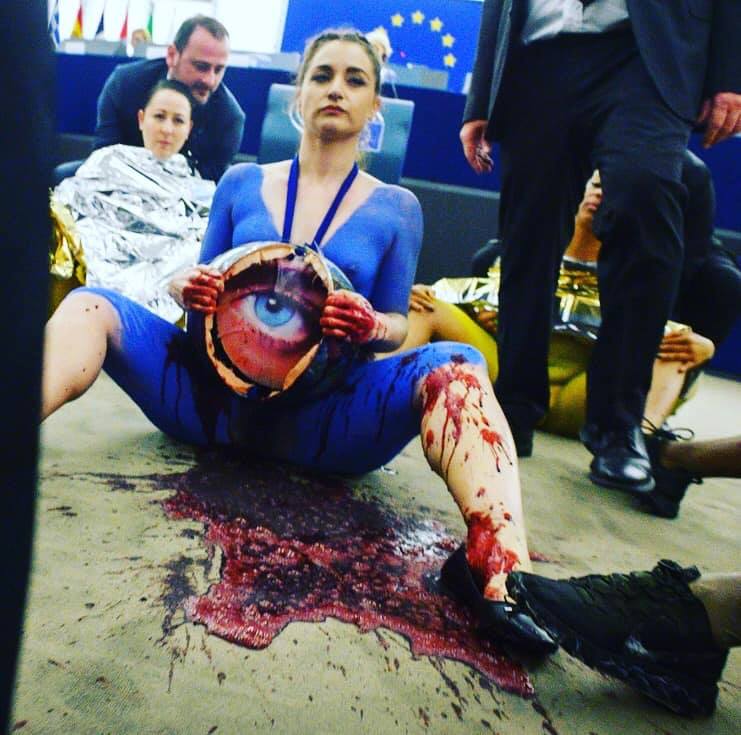
Deborah de Robertis protesting at the European Union parliament on May 20. Courtesy the artist.
Art and the Fight for Europe
Meanwhile, in the lead up to the vote, the blue-and-yellow EU flag become a potent symbol of togetherness and tolerance—and a banner for the cultural elite.
At Galerie König’s gift shop, you could purchase the brand Souvenir’s “EUnify” hoodie with an image of the EU flag for €59 ($66). The center-left candidate Katarina Barley wore one while campaigning in the Berlin neighborhood of Friederichshain-Kreuzberg. But it didn’t prevent her or her party, the Social Democrats, from losing an historic amount of seats. (The party, which drew 27.3 percent of the vote in Germany in 2014, dropped to only 15.5 percent.)
Elsewhere, Luxembourg artist Deborah de Robertis staged a performance at the EU parliament on May 20, barging onto the floor with five topless female performers painted yellow and blue. After de Robertis opened her costume to reveal a large, bleeding eyeball, the group was covered in blankets and escorted out. The artist, who says she is an ecofeminist, later shared images of the event with the ominous hashtag #EuropeIsWatchingYou.
“Before the actual results, we reincarnated Europe as a woman in an artistic performance, because art stays a strong political tool,” she told artnet News. “Art and Europe should have no borders.”
Art as a symbolic weapon is a lesson the right, on the other side of the spectrum from de Robertis, seems to have caught onto as well. In Germany, the right-wing party AfD created a campaign poster with an image of French painter Jean-Léon Gérôme’s painting The Slave Market (1866). The imagined scene, of a group of North African or Middle Eastern men with a nude slave woman, was accompanied in the poster by a shocking phrase: “Don’t let Europe become ‘Euro-Arabian!'”
The Clark Institute in Massachusetts, where the Orientalist painting hangs, condemned the AfD for using the work, which the group did as part of a larger campaign called “Learning from Europe’s History” that included images of works by Pieter Bruegel the Elder and Giuseppe Arcimboldo.
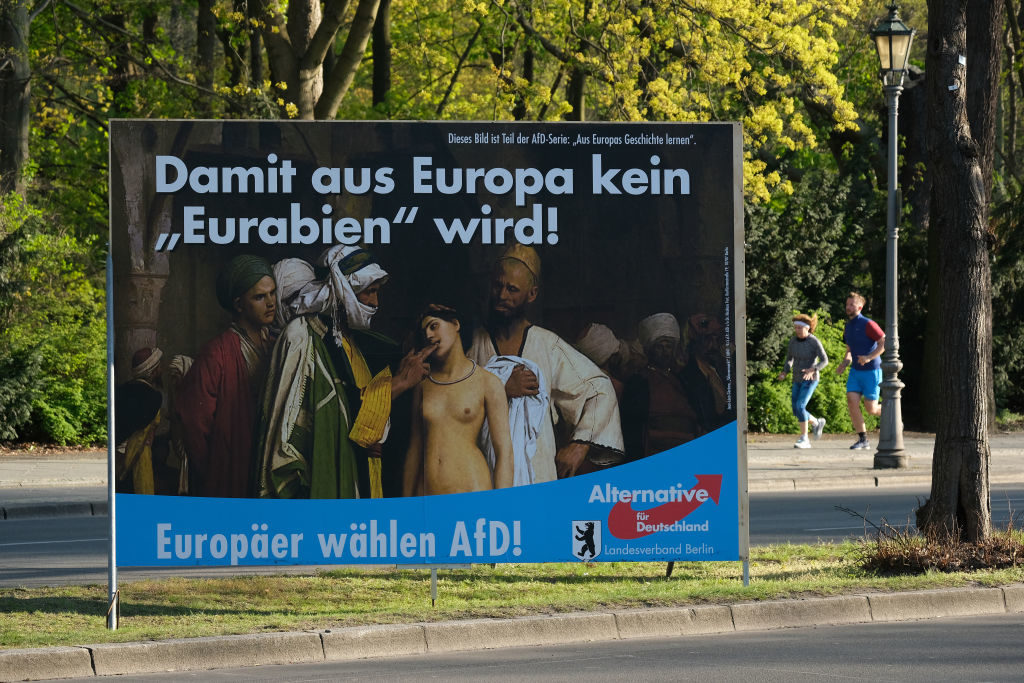
A billboard for the European elections by the right-wing Alternative for Germany (AfD) political party depicts part of the painting The Slave Market by Jean-Léon Gérôme. Photo by Sean Gallup/Getty Images.
Risk of a No-Deal Brexit
In the UK, where the political stalemate continues following the resignation last week of Prime Minister Theresa May, the newly formed Brexit Party came out on top with more than 30 percent of the vote. Her resignation as the leader of the Conservative Party, and the election success of the Brexit Party with 29 seats, increase the chance of a no-deal Brexit.
But the vote, far from giving the new party a mandate, proved that the nation is still split on the path forward, with the Liberal Democrats and the Labor Party cumulatively also picking up 26 total seats.
Random International co-founders Hannes Koch and Flo Ortkrass, which has studios in London and Berlin, says that it is important to remember that the majority of UK voters chose “Remain” parties. But they are concerned about a lack of a united front against Brexit-supporting politicians. “[Remainers] need to learn to do a Euro-style coalition,” he says, adding that, if they don’t, Britain “will be led into darkness by a xenophobic, incompetent, self-absorbed demagogue donkeys.” They add that hardline Brexit politicians never speak about the “utter brain, business, and cultural drain that the UK is experiencing.”
The gallerist Aeneas Bastian, who has spaces in Berlin and London, hopes Britain will not crash-out of the EU. “From a practical perspective, I am not concerned for the London art scene post-Brexit, so long as it has a concrete form and we are not left with the ambiguities of a no-deal [exit],” Bastian says.
Despite the seeming inevitability of some form of Brexit, some people, like art dealer Thaddaeus Ropac, are making direct contributions to the European cause. Works from a group show held at his London gallery ahead of the vote will go on up for auction on June 3 with Simon de Pury leading the sale. It is expected to raise as much as £1.5 million ($1.9 million) for various European cultural projects.
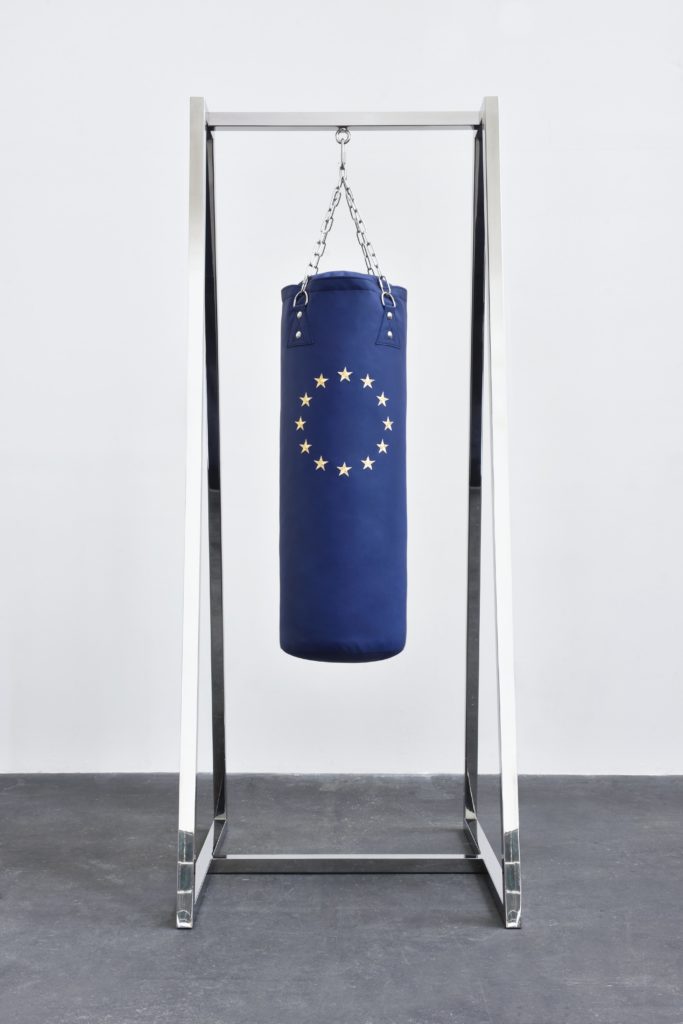
Elmgreen & Dragset, Anger Management (2018). Courtesy the artists and Victoria Miro, London/Venice.
“In Switzerland, we are not part of the European Union and each year, in the lead up to Art Basel, it gets tremendously busy at the various customs offices around Basel,” says Sven Eisenhut, the founding director of Photo Basel. “Not being in the EU feels a bit like taking a rather complex, pricey detour. All in all, having different systems within Europe is a hassle and a burden for everyone involved. The only ones profiting from it are logistics companies, and the federal tax [collectors]. For the rest, it is costly.”
On top of that, the EU has invested heavily in UK cultural institutions, pumping nearly £14 million (€15.9 million) into the coffers of 96 organizations in 2018, according to a report from Creative Europe, an arm of the EU. For the foreseeable future, Creative Europe says the UK remains eligible to participate in its programs.
“I voted last Sunday in the European elections with a sense of urgency and commitment to Europe,” says the Paris-based gallerist Kamel Mennour. “But I am worried about the highest-ever number of populists and nationalists elected to parliament, their anti-immigration policies, and how this will affect the arts.”
